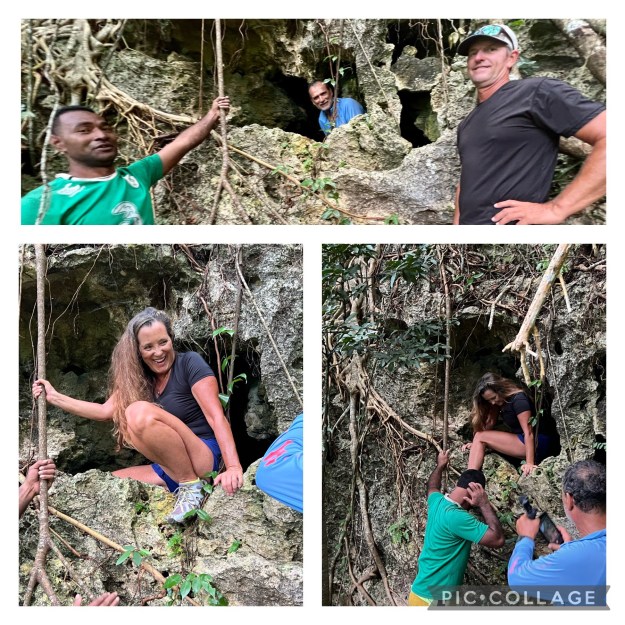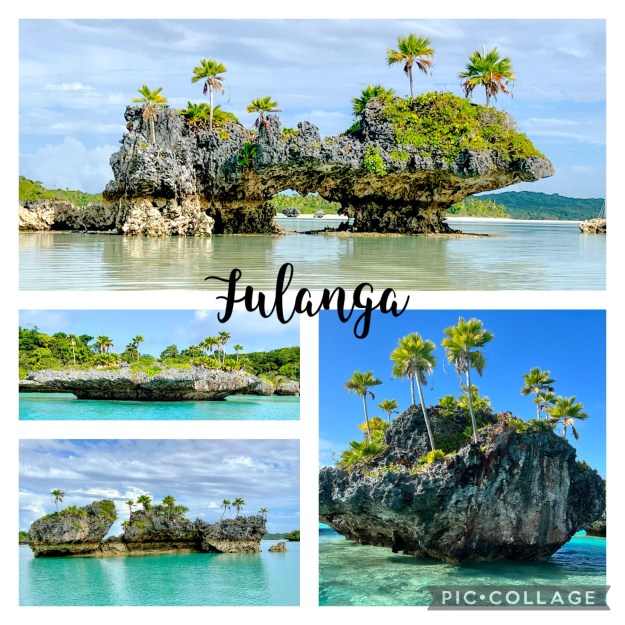We leave Yadu Island riding a huge high from our manta experience and head to the large island of Kadavu. About six or seven weeks ago, we visited the south side of Kadavu, but we did not have a chance to visit the north side. We motor-sailed 12nm from Yadu to the bay of Tomba Ni Ndaku and visit the Vunisei village.
It was a beautiful, calm day to be out on the water. A slight downwind run with clear, sunny skies. We arrived the bay of Tomba Ni Ndaku around 1400, dropped the hook in a nook of the bay and headed into the village of Vunisei to do sevusevu. Can you see the village in the lower photo tucked in the mangroves?

Vunisei Bay, Kadavu
The village of Vunisei is not really visible from our anchorage. We have to weave our way through a lot of mangroves before the beautiful village is revealed. On our way in we encounter a panga with loads of kids happy to wave and shout “BULA” to us.

Welcome to the Village
We’ve been in Fiji now for almost 3 months and have performed the “short” sevusevu a dozen times. But each ceremony has been the short-condensed version where the chief receives us, claps 3x, prays, welcomes us to the village, and we have a short chat. However, this time, we get the privilege of a full and complete sevusevu ceremony!
We are greeted by Joe, the chief’s son who takes us to the town hall where the ceremony is to take place. Joseph, the chief arrives along with the torang-ni-koro (headman), and 7 other men in the village. Yep, I am the only woman present.
We politely explain that this is our first full sevusevu ceremony hoping they explain what they are doing along the way — which they happily did.
Sevusevu
The fresh kava root that we gifted to the chief is handed to his son Joe to pound into powder (step 1, upper left corner). It is placed in a metal cylinder which is in a hole in the floor. He then uses a steel metal shaft to pound it into the cylinder. Matt thinks he used a propeller shaft from a boat because it looked remarkably similar.
Step 2 includes placing the freshly ground powder into the tree bark (see the dried tree bark on the kava bowl in the upper right corner photo). The tree bark is long and sort of looks like hair but is wicked strong. Water is added and then the powder is all rolled and rolled and rolled amongst the tree bark in the water. Infusing the kava with the taste and smell of the bark. This is new to us as we were told and had seen other villages use a tea towel instead of the tree bark.
Step 3 is when the liquid is cleaned and all powder residue is removed using the tree bark.
Step 4 is the final preparation for the grog. All remnants of the kava root and tree bark are gone and the grog is ready to consume. Using a coconut cup, the first one is handed to the chief, then the toranga-ni-koro, then me! Oh dear, no pressure, please don’t gag or make a face.
The Grog and its effects
I clap once, say “bula”, and gulp the entire cup in one go, then clap 3x and say “Vinaka.” I think to myself, “well done.” Next up is Matt. This is his first-time tasting grog and I am curious to see how it goes. He somehow manages to dribble a wee bit down his chin, but other than that it goes swimmingly well.
The cup is passed around a second time before we are able to extract ourselves politely.
Within a few minutes of drinking the second cup we feel a slight numbing sensation in our mouth, tongue, and throat. It did not last long, maybe 30-45 minutes. Keep in mind that the villagers do not drink, this is their recreational drink of choice.
Vunisei School
We walk to the top of the mountain just behind the village to visit the school. I had brought a few school supplies for the teachers and wanted to present them personally.

From the hilltop, we had gorgeous views of both Kadavu village and Vunisei village.

On the way back to the town hall we came across loads of children. There are 70 people who live in the village and about 25 of them are children.

Back to the Boat
We go back to the village chief and leaders and politely thank them for their hospitality and for walking us through the entire sevusevu ceremony. They had wanted us to stay for more kava but 2 cups is all I can take so we graciously declined.
The water was flat calm when we left. I just can’t get over how beautiful the entrance and exit is to this village. What a lovely way to come home every day.

Matt got out the drown and took some beautiful photos at sunset. And it just keeps getting better and better as the sun goes down.

Tomba Ni Ndaku is a beautiful anchorage with a lovely village! We were invited to church the next day, but unfortunately, we had to move on to our next adventure.
We prepared to leave the next day at dawn and were greeted with a gorgeous moon set.

The events from this blog occurred in early September 2022. Our blog posts run 6-8 weeks behind actual events. We play with the manta rays while they eat and get cleaned. Check out this blog post!


















